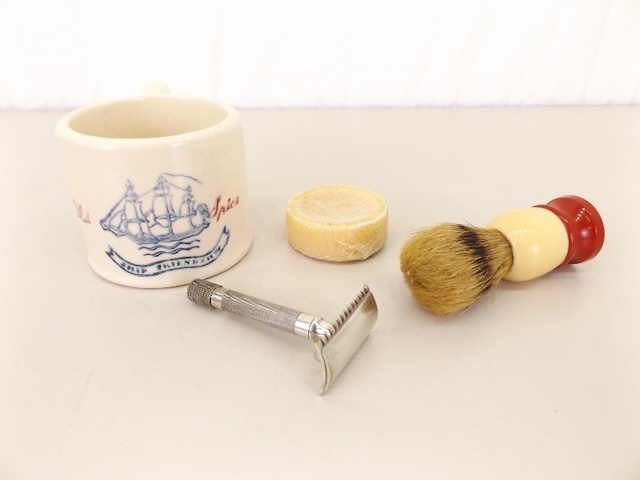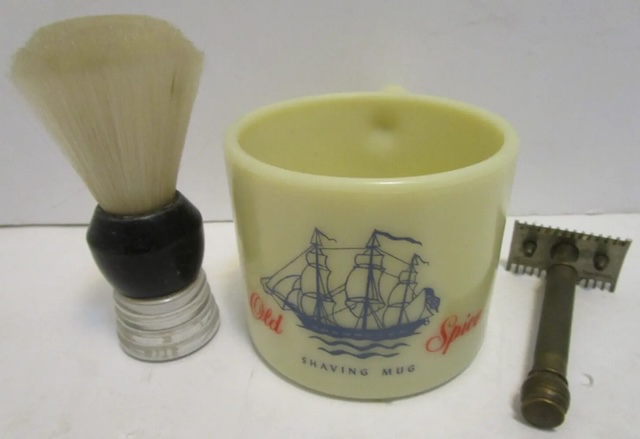In an era dominated by convenience and speed, few things evoke nostalgia like the vintage shaving set. This trio of tools—a safety razor, shaving brush, and shaving mug—served generations of men who saw shaving not merely as a task, but as a mindful ritual. Today, as traditional grooming experiences make a comeback, the vintage shaving set offers a glimpse into a time when craftsmanship, patience, and self-care defined a man’s daily routine. Let’s take a closer look at what made these tools so enduring and why they’re seeing a modern revival.
The Components of the Vintage Shaving Set

At the heart of the vintage shaving experience lies the simplicity and elegance of its core components. Each piece had a specific role in achieving the perfect shave, and together, they created an experience unmatched by modern alternatives.
- The Safety Razor: Built to last, the safety razor was often crafted from high-quality metal and featured a single, replaceable blade. Unlike today’s plastic disposable razors, it was designed with sophistication and durability in mind. Men took pride in their razors, and many safety razors became family heirlooms, passed down from one generation to the next.
- The Shaving Brush: Usually made with bristles from badger or boar, the shaving brush was essential for creating a rich, luxurious lather. Besides whipping up a foam from shaving soap, the brush also served as a gentle exfoliator, lifting facial hair for a closer shave. The soft bristles, along with the ritual of lathering, added a tactile pleasure to the shaving experience.
- The Shaving Mug: The shaving mug, often adorned with personal engravings or decorative patterns, wasn’t just functional—it was a statement piece. This was where the shaving soap was stored and transformed into lather. It added a personal touch to the set, making each morning ritual feel intimate and refined.
Each of these elements contributed to the unique appeal of the vintage shaving set. While modern razors prioritize convenience, the vintage set encouraged a slower, more mindful approach to grooming.
A Tradition Passed Down Through Generations
In the 19th and early 20th centuries, the vintage shaving set symbolized more than just grooming—it was a rite of passage. For many men, their first shave was a memorable event, marking the transition from boyhood to manhood. Fathers often shared this tradition with their sons, teaching them how to handle the razor and build a lather with skill and care.
This daily ritual fostered a sense of pride and self-discipline. A boy’s first shaving set, often gifted by his father, held sentimental value and became a cherished possession. In barbershops, too, the communal aspect of shaving was celebrated. Men gathered not only to groom themselves but to share stories, exchange news, and engage in the camaraderie of shared routines. Barbers, regarded as artisans, wielded their tools with skill, transforming the simple act of shaving into an art form.
The Decline of the Vintage Shaving Set
By the mid-20th century, convenience took precedence over tradition, and the invention of disposable razors and electric shavers quickly became popular. These new tools allowed men to shave quickly and efficiently, without the need for elaborate preparations. The once-beloved vintage shaving set started to fade from the mainstream, relegated to bathroom cabinets and forgotten drawers.
For many, the shift to disposables marked the end of a mindful ritual. Disposable razors didn’t require care or skill, and the practice of whipping lather became a relic of the past. However, while convenience won out for a time, the vintage shaving set didn’t completely disappear—it found a new place in the collections of enthusiasts and traditionalists who valued its craftsmanship and history.
Interesting Facts and History Surrounding the Vintage Shaving Set

Understanding the history of the vintage shaving set adds to its allure. Let’s explore some fascinating facts about these classic tools:
- The Birth of the Safety Razor: The safety razor, a staple in vintage shaving kits, was invented by the Kampfe Brothers in 1880. However, it was King Camp Gillette who revolutionized the industry in 1901 by introducing the disposable razor blade, making shaving more accessible and safer than ever.
- Barbershop Culture: In the early 1900s, barbershops were much more than grooming centers. They were hubs of social interaction where men discussed politics, shared stories, and forged friendships. The barber, with his skillful use of the shaving set, was a respected figure who provided not only a service but a place of community.
- Shaving Brushes as Artisanal Tools: Badger hair brushes, highly prized for their water retention and softness, were often handmade, making them treasured items in a man’s grooming kit. High-quality brushes represented not just luxury but also an appreciation for the artistry in everyday tools.
- The Shift to Modern Razors: By the 1970s, disposable razors had largely taken over the market. Companies like Gillette and Schick dominated, and the vintage shaving set became more of a nostalgic memory. However, recent years have seen a renewed interest in these classic grooming tools, with many men seeking them out for their superior quality and craftsmanship.
The Modern Revival of the Vintage Shaving Set

Today, the vintage shaving set has made a strong comeback, especially among men who value tradition, craftsmanship, and sustainability. In an age where disposable products dominate, many are drawn to the idea of a reusable, high-quality tool that aligns with eco-friendly practices.
The process of preparing a brush, lathering up, and handling a safety razor brings a sense of peace in our fast-paced world. It’s a deliberate and mindful ritual that many find grounding and satisfying. For some, it’s a form of self-care that goes beyond shaving; it’s a moment to slow down and connect with the simplicity of the past.
Communities dedicated to traditional shaving have sprung up online, where enthusiasts share tips, trade vintage razors, and discuss the finer points of maintaining their sets. Barbershops have also embraced this resurgence, with many offering classic wet shaves that harken back to the barbershop experiences of the early 20th century.
Why the Vintage Shaving Set Still Matters

In an age where instant gratification is the norm, the vintage shaving set represents a different mindset—one that values quality, tradition, and the joy of a well-executed task. Each component of the set, from the precision of the safety razor to the craftsmanship of the shaving brush, speaks to a time when daily routines were cherished rather than rushed.
For many, using a vintage shaving set isn’t just about grooming; it’s about connecting to a timeless tradition. The process encourages mindfulness and transforms an ordinary task into a relaxing ritual. This sense of nostalgia and respect for craftsmanship explains why the vintage shaving set continues to captivate those who seek a return to simplicity and elegance.
Conclusion
The vintage shaving set is more than a collection of grooming tools—it’s a symbol of a bygone era when self-care was an art. In every stroke of the safety razor and swirl of the shaving brush, there’s a connection to history, tradition, and an appreciation for craftsmanship. As men increasingly rediscover the charm of vintage shaving, this timeless ritual serves as a reminder that some things truly stand the test of time. Embracing the vintage shaving set isn’t just about getting a closer shave; it’s about finding a slower, more meaningful approach to life’s daily routines.


